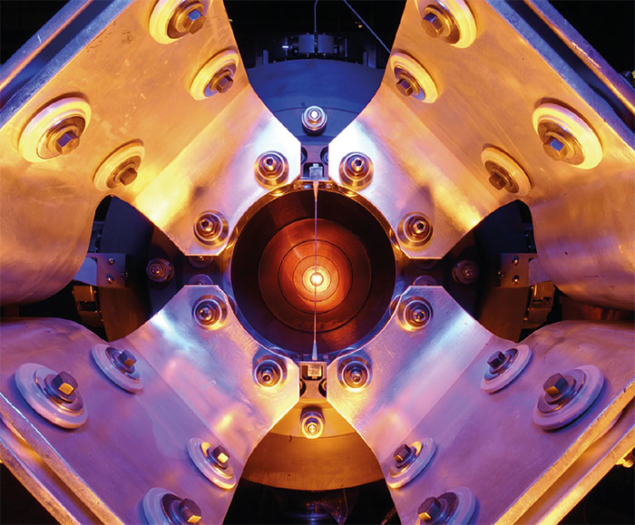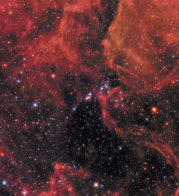Results shed light on the ordering of neutrino masses.

Image credit: Fermilab.
The breakthrough results from the Super-Kamiokande and SNO experiments, which showed that neutrinos oscillate between their three flavours, marked the start of nearly two decades of tremendous progress in neutrino physics. The basic features of the three-flavour neutrino oscillation framework have been fleshed out, and the NOvA experiment in the US – which presented its latest results at the Neutrino 2016 conference in London earlier this month – is poised to address many of the remaining unknowns related to neutrino masses and their mixing.
Among these is whether neutrinos obey a “normal” or “inverted” mass hierarchy: that is, whether the mass eigenstate with the least νe content (called ν3) is the heaviest or lightest of the three (see “A portal to new physics”). A second set of questions relate to the flavour admixture of the ν3 state. Past experimental data are consistent with ν3 being equal parts νμ and ντ, in addition to a small amount of νe. But is there a new symmetry that underlies this apparent νμ/ντ equality? And if the equality breaks down as measurements improve, which flavour will dominate? A third major unknown is whether neutrinos violate CP symmetry, as allowed by the complex phase δ of the leptonic mixing matrix.
Addressing the unknown
NOvA was conceived to address these unknowns using two detectors together with the intense beam of muon neutrinos provided by Fermilab’s NuMI neutrino source. NOvA’s 300 tonne near detector, which is located 1 km downstream of the neutrino source, measures the rate, energy spectrum and flavour composition of the neutrino beam prior to significant flavour oscillations, while the 14,000 tonne far detector is located 810 km downstream in northern Minnesota. The detectors are identical in their structure, consisting of 4 × 6 cm liquid scintillator-filled PVC cells in alternating planes in order to provide two orthogonal 2D views of particle trajectories.
NOvA has been collecting data with the NuMI beam since February 2014, and full operations began the following October upon completion of the far detector (CERN Courier July/August 2014 p30). As of May 2016, the experiment has accumulated 16% of its planned total. The results released at Neutrino 2016 are based on this data set, and highlighted here are the measurements of νμ → νμ (corresponding to muon-neutrino survival) and νμ → νe (electron-neutrino appearance).

To identify the flavour of an interacting neutrino, researchers look for tell-tale signs of a muon or an electron in the recorded event. Muons produced in charged-current νμ interactions in NOvA leave long straight tracks of detector activity that can span hundreds of cells (see the image of a muon-neutrino interaction in the NOvA detector). Electrons, in contrast, create more compact electromagnetic showers with well-characterised longitudinal and transverse profiles. An important background to both the νμ and νe charged-current channels comes from neutral-current interactions, whereby the neutrino exits the detector and leaves behind only a hadronic recoil system. Neutral pions in these recoil systems can mimic electrons, while charged pions can mimic muons.
To keep this background at bay in the νμ→ νμ measurement, each recorded track is assigned a muon likelihood based on key track features such as overall length and the rate of energy deposition. Additionally, each event must be far enough from the detector edges to ensure that the entire final state has been recorded and that the event is not due to an incoming cosmic ray. For the latest data, the NOvA team predicts 470 selected νμ charged current interactions in the far detector if neutrino oscillations do not occur. Only 78 such interactions were observed, in line with the well-established result originally observed by Super-Kamiokande that muon neutrinos are indeed oscillating into other flavours as they travel.
Non-maximal mixing
The real value of these data, though, comes from examining the precise energy dependence and amplitude of the νμ disappearance signal, which depends most strongly on the mass splitting |Δm232| and the mixing angle θ23. The ranges of these parameters allowed by the latest NOvA data are shown above. NOvA’s results are consistent with prior measurements but show an intriguing preference for non-maximal mixing – that is, a preference for sin2θ23 ≠ 0.5 and thus a break in the ν3 state’s apparent flavour symmetry. Whether this preference becomes conclusive or fades away will be addressed as NOvA continues to accumulate data.

Image credit: NOvA Collaboration.
On the νe appearance side, distinguishing signal and background is a trickier affair due to their stronger mutual similarities and to the low probability for νμ→ νe oscillations. For its latest 2016 νe analysis, the NOvA team has developed an event-classification algorithm based on techniques from the image analysis community, notably convolutional neural networks and deep learning. A total of 33 candidate νe events were isolated in the latest data, which is far above the expected background of eight, and therefore represents a clear observation of νe appearance – in line with data from T2K.
The νμ→ νe oscillation probability, and therefore this measurement, is a function of several key unknowns that NOvA is pursuing. The probability will be 40 –70% higher for a normal mass hierarchy than for an inverted one, with the opposite correspondence holding for antineutrinos. This dependence stems from the so-called matter effect arising from neutrinos scattering off electrons in the Earth, and the effect is intentionally made large in NOvA by choosing the longest-distance baseline possible. Next, the phase δ of the leptonic mixing matrix can either increase or decrease the νμ→ νe probability by a similar amount, and this effect is also opposite for neutrinos and antineutrinos. Finally, the probability increases or decreases for neutrinos and antineutrinos alike, in step with sin2θ23. This last dependence is complementary to the behaviour of the νμ→ νμ channel, which is better at detecting non-maximal mixing but cannot on its own distinguish which way the ν3 flavour mixing breaks.
The present electron-neutrino appearance results, which point to a probability on the higher end of the range, have already started carving up parameter space. But NOvA must collect both neutrino and antineutrino data to disentangle all the above effects, particularly in light of possible non-maximal mixing. The first large antineutrino run for the experiment is slated to begin next spring.
In addition to accruing neutrino and antineutrino exposure for the flagship oscillation measurements, this summer’s results also included a first look at the total neutral current rate in the far detector, for which a deficit could suggest mixing with light sterile neutrinos. No deviation is seen thus far, but with both detectors operating smoothly and the NuMI source running at high power, NOvA is set to play a central role in illuminating the neutrino sector in the coming years.
• CERN Courier went to press just as Neutrino 2016 got under way. Other expected highlights of the conference include new neutrino oscillation measurements from the T2K experiment in Japan.





